#wooden artifacts
Text
476,000 years ago
"To date these objects, the researchers analyzed minerals in the sand that surrounded them through a technique called luminescence dating, Geoff Duller, a co-author of the study and dating expert at Aberystwyth University in Wales, tells the AP. The smaller wooden objects were buried around 390,000 and 324,000 years ago."
There are good pics and diagrams of the finds in this Nature article. Found tools - flake tools, cleavers, handaxes and core axes - and the wooden structure. "This construction has no known parallels in the African or Eurasian Palaeolithic."
"...before this new find, the oldest known structure made of wood was only 9,000 years old.." Smithsonian
#archeology#Kalambo Falls#zambia#wooden artifacts#hand tools#oldest human building#2019#early stone age
3 notes
·
View notes
Text
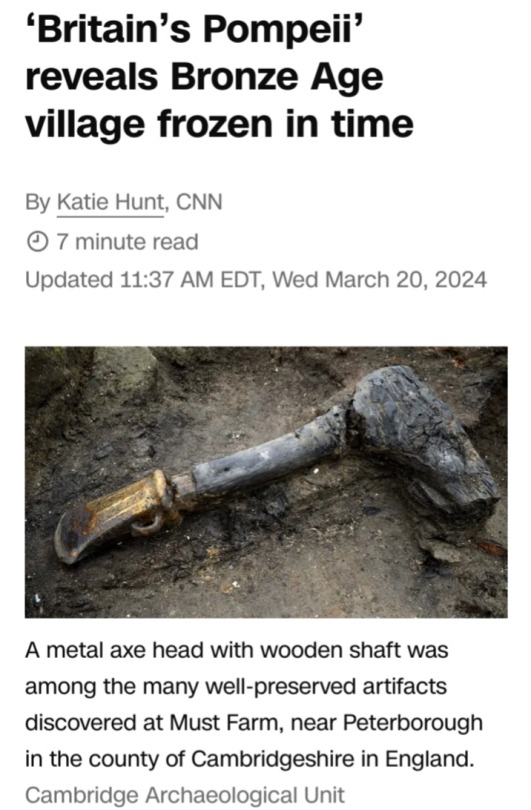
(CNN) — It’s late summer 2,850 years ago. A fire engulfs a stilt village perched above a boggy, slow-moving river that weaves though the wetlands of eastern England.
The tightly packed roundhouses, built from wood, straw, turf, and clay just nine months earlier, go up in flames.
The inhabitants flee, leaving behind all their belongings, including a wooden spoon in a bowl of half-eaten porridge.
There is no time to rescue the fattened lambs, which are trapped and burnt alive.
The scene is a vivid and poignant snapshot, captured by archaeologists, of a once thriving community in late Bronze Age Britain known as Must Farm, near what’s now the town of Peterborough.
The research team published a two-volume monograph on Wednesday that describes their painstaking $1.4 million (£1.1 million) excavation and analysis of the site in the county of Cambridgeshire.
Described by the experts involved as an “archaeological nirvana,” the site is the only one in Britain that lives up to the “Pompeii premise,” they say, referencing the city forever frozen in time by the eruption of Mount Vesuvius in AD 79 that has yielded unparalleled information about ancient Rome.
“In a typical Bronze Age site, if you’ve got a house, you’ve probably got maybe a dozen post holes in the ground and they’re just dark shadows of where it once stood.
If you’re really lucky, you’ll get a couple of shards of pottery, maybe a pit with a bunch of animal bones.
This was the complete opposite of that process. It was just incredible,” said Chris Wakefield of the Cambridge Archaeological Unit at the University of Cambridge, an archaeologist and member of the 55-person team that excavated the site in 2016.
"All the axe marks had been used to shape and sculpt the wood. All of those looked fresh, like they could have been done last week by someone,” Wakefield added.
The remarkably preserved condition of the site and its contents enabled the archaeological team to draw comprehensive new insights into Bronze Age society — findings that could overturn the current understanding of what everyday life was like in Britain during the ninth century BC.

Must Farm domesticity — and a mystery
The site, which dates to eight centuries before Romans arrived in Britain, revealed four roundhouses and a square entranceway structure, which stood approximately 6.5 feet (2 meters) above the riverbed and were surrounded by a 6.5-foot (2-meter) fence of sharpened posts.
The archaeologists believe the settlement was likely twice as big. However, quarrying in the 20th century destroyed any other remains.
Though charred from the fire, the remaining buildings and their contents were extremely well preserved by the oxygen-starved conditions of the fens, or wetlands, and included many wooden and textile items that rarely survive in the archaeological record.
Together, traces of the settlement paint a picture of cozy domesticity and relative plenty.
The researchers unearthed 128 ceramic artifacts — jars, bowls, cups and cookware — and were able to deduce that 64 pots were in use at the time of fire.
The team found some stored pots neatly nested.
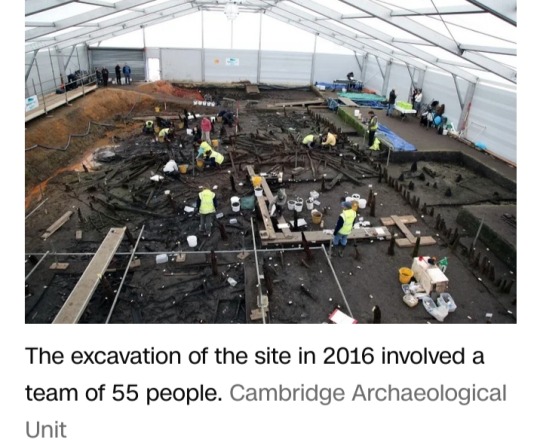
Textiles found at the site made from flax linen had a soft, velvety feel with neat seams and hems, although it wasn’t possible to identify individual pieces of clothing.
Wooden artifacts included boxes and bowls carved from willow, alder and maple, 40 bobbins, many with threads still attached, various tools, and 15 wooden buckets.
“One of those buckets … on the bottom of it were loads and loads of cut marks, so we know that people living in that Bronze Age kitchen when they needed an impromptu chopping board, were just flipping that bucket upside down and using that as a chopping surface,” Wakefield said.
“It’s those little moments that build together to give a richer, fuller picture of what was going on.”

The circumstances of the event that brought it all to a halt are still a bit of a mystery.
The researchers believe the fire took place in late summer or early autumn because skeletal remains of the lambs kept by one household showed the animals, typically born in spring, were three months to six months old.
However, what exactly caused the devastating fire remains unclear. The blaze could have been accidental or deliberately started.
The researchers uncovered a stack of spears with shafts over 10 feet (3 meters) long at the site, and many experts think that warfare was common in the time period.
The team worked with a forensic fire investigator but ultimately couldn’t identify a specific “smoking gun” clue pointing to the cause.
“An archaeological site is a lot like a jigsaw puzzle. At a typical site you have 10 or 20 pieces out of 500,” Wakefield said.
“Here, we had 250 or 300 pieces and we still couldn’t get the complete picture on how this big fire broke out.”
Mike Parker Pearson, a professor of British later prehistory at the Institute of Archaeology at University College London, described both the report and the site “as exceptional.” He wasn’t involved in the research.
“The fire may have been disastrous for the inhabitants but it is a blessing for archaeologists, a unique snapshot of life in the Bronze Age,” he said via email.
Upending ideas about Bronze Age society
The contents across the four preserved houses were “remarkably consistent."
Each one had a tool kit that included sickles, axes, gouges, and handheld razors used to cut hair or cloth.
With almost 538 square feet (50 square meters) of floor space in the largest, each of the dwellings appeared to have distinct activity zones comparable to rooms in a modern home.
“By plotting the positions of all these finds — pots, loomweights, tools, and even sheep droppings, the archaeological team have reconstructed the houses’ internal use of space,” Parker Pearson noted.
“The kitchen area was in the east, the storage and weaving area in the south and southeast with the penning area for lambs, and the sleeping area in the northwest, though we don’t know where the doorway was for each house.”
Not all the items were of practical use, such as 49 glass beads plus others made of amber.
Archaeologists also unearthed a woman’s skull, smooth from touch, possibly a keepsake of a lost loved one.
Some of the items the researchers found will go on display starting April 27 in an exhibition titled “Introducing Must Farm: A Bronze Age Settlement” at the Peterborough Museum and Art Gallery.
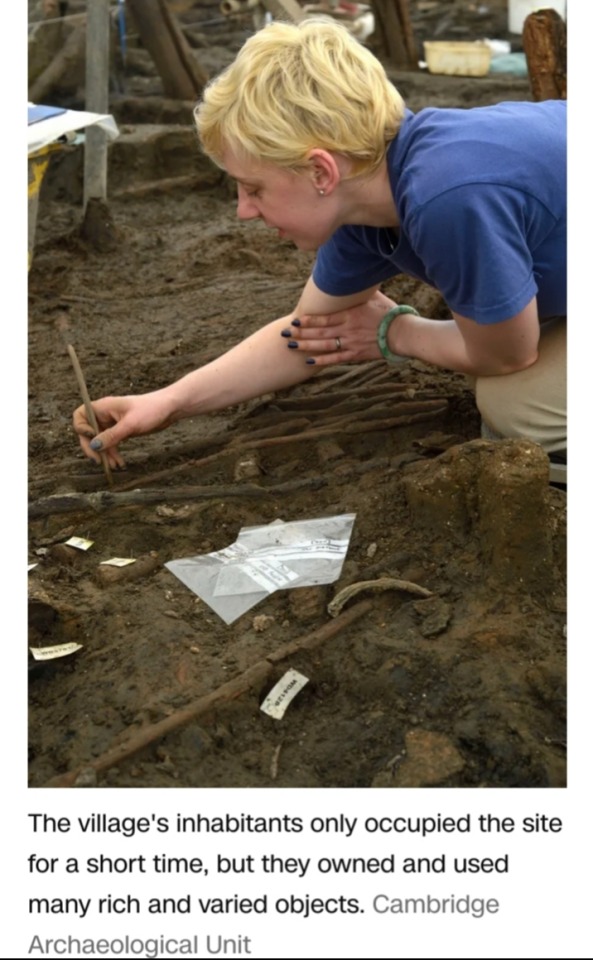
Lab analysis of biological remains revealed the types of food the community once consumed.
A pottery bowl imprinted with the finger marks of its maker held a final meal — a wheat grain porridge mixed with animal fat.
Chemical analyses of the bowls and jars showed traces of honey along with deer, suggesting the people who used the dishes might have enjoyed honey-glazed venison.
Ancient excrement found in waste piles below where the houses would have stood showed that the community kept dogs that fed on scraps from their owners’ meals.
And human fossilized poop, or coprolites, showed that at least some inhabitants suffered from intestinal worms.
The waste piles, or middens, were one line of evidence that showed how long the site was occupied, with a thin layer of refuse suggesting the settlement was built nine months to a year before it went up in flames.
"Two other factors supported that line of reasoning," Wakefield said.
“The second was that a lot of the wood that was used in the construction was unseasoned, it was still effectively green, it hadn’t been long in position,” he said.
“The third one is that we have a lack of the kind of insects and animals that are associated with human habitation."
"It wouldn’t be long before beetles would worm (in) … but there’s no evidence of any of that in any of the 18,000 plus timbers.”
The fact that the site, with its rich and varied contents, was in use for only a year upended the team’s preconceived “visions of everyday life” in the ninth century BC.
It may suggest that Bronze Age societies were perhaps less hierarchical than traditionally thought, according to the 1,608-page report.
“We are seeing here not the accumulation of a lifetime, but just a year’s worth of materials,” the authors noted in the report.
“It suggests that artefacts such as bronze tools and glass beads were more common than we often imagine and that their availability may not in fact have been restricted.”
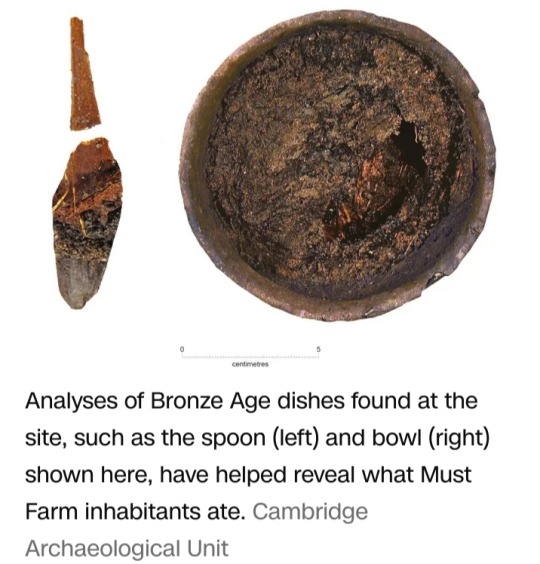
#Must Farm#Late Bronze Age#Late Bronze Age Britain#Cambridgeshire#Peterborough#archaeological nirvana#Pompeii premise#Mount Vesuvius#AD 79#Bronze Age#Chris Wakefield#Cambridge Archaeological Unit#University of Cambridge#9th century BC#Britain's Pompeii#archaeology#archaeologists#ceramic artifacts#wooden artifacts#forensic fire investigator#archaeological site#Institute of Archaeology#University College London#Peterborough Museum and Art Gallery#artefacts#Mike Parker Pearson#history
4 notes
·
View notes
Text
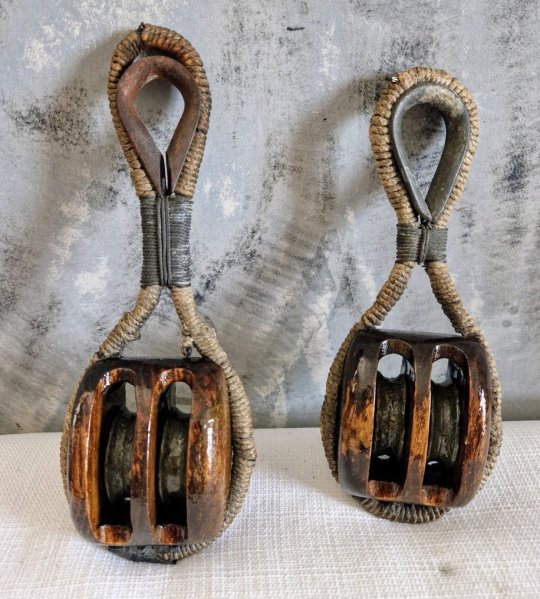
Two wooden blocks, late 19th century- early 20th century
95 notes
·
View notes
Text
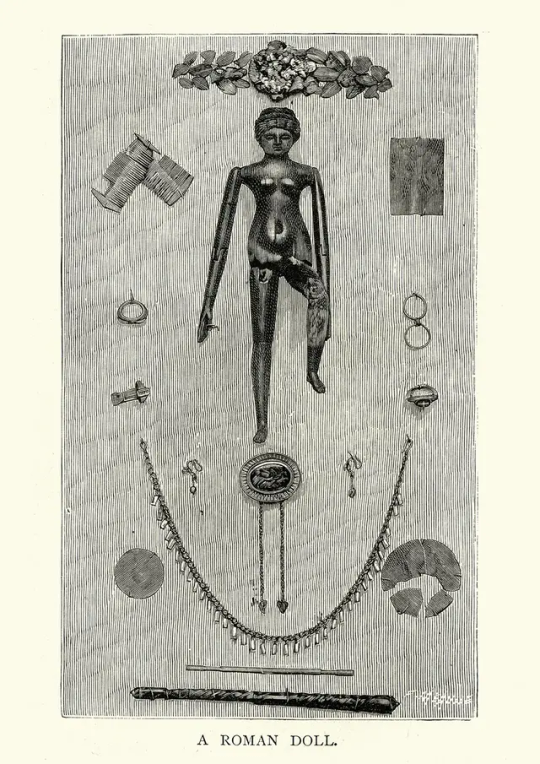

Source identifier: PCM (Hades Legacy Identifier / Struc ID) Content: Printed on border: "The above picture shows a jointed doll and other articles recently found in the sarcophagus of a young lady of ancient Rome, named Crepereia Trifena." Includes additional text.Content: Illegible engraver signature on image.
The Miriam and Ira D. Wallach Division of Art, Prints and Photographs: Picture Collection, The New York Public Library. "A Roman doll" The New York Public Library Digital Collections. 1894. https://digitalcollections.nypl.org/items/510d47e4-37c7-a3d9-e040-e00a18064a99
#Roman Doll#Crepereia Trifena#The New York Public Library#artifacts#ancient artifacts#doll#dolls#ancient#wooden articulated doll#articulated doll#jointed doll
54 notes
·
View notes
Text
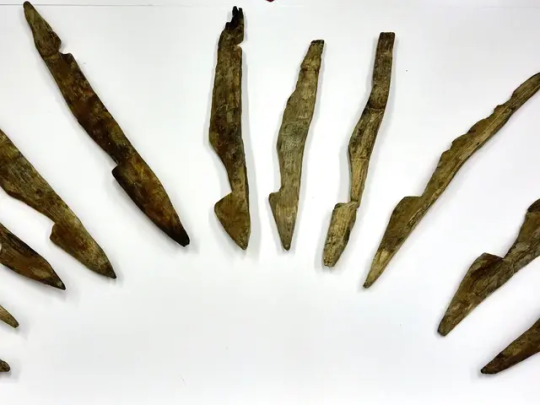
Roman Fort Defended by Wooden Stakes Discovered in Germany
For the first time, archaeologists have discovered well-preserved sharpened wooden stakes used to deter attacks from enemies at an ancient Roman military camp from the first century CE.
Researcher Frederic Auth from Frankfurt’s Goethe University discovered the spikes at an excavation site in the German town of Bad Ems.
Installations of these martial-looking wooden structures, comparable to modern barbed wire and metal bird spikes, have been referenced in literature and by Julius Caesar. But prior to Auth’s discovery, none had been found.
Experts believe the military had a presence at the site specifically because of the Romans’ investment in the lucrative precious metal mining operation there, which would need defense against sudden raids for the valuable raw material. But Goethe University archaeology professor Markus Scholz said further research is necessary to verify this theory.
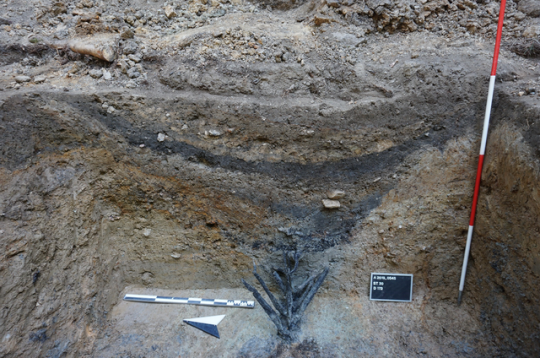
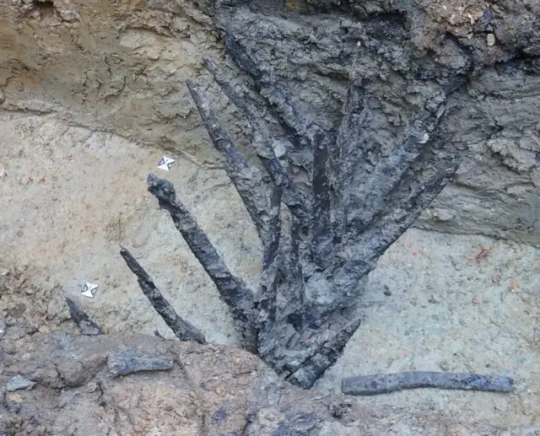

The university’s archaeology department has been overseeing a multiyear excavation project in the area focused on the Roman search for silver ore in the 1st century CE and the establishment of two military camps.
A hunter’s observations of color differences in a grain field, a sign of subsurface structures, triggered the excavations in 2016. A drone photo found a track crisscrossing the field that was actually a double ditch, framing a Roman camp. The spikes were preserved through the area’s damp soil.
According to a statement from the university, geomagnetic prospecting later revealed a 20-acre military camp with about 40 wooden towers.
Auth also led a student team to discover a smaller military camp made of wood that held approximately 40 men, located two kilometers away.
Notably, the spiked wooden defense structure was discovered on the second-last day of the team’s excavations, along with a coin minted in 43 CE. The coin was proof that the military structure could not have been built in connection with ancient Roman fortifications known as the Limes, which were built around 110 CE.
By Karen K. Ho.

#Roman Fort Defended by Wooden Stakes Discovered in Germany#Bad Ems#ancient artifacts#archeology#archeolgst#history#history news#ancient history#ancient culture#ancient civilizations#roman history#roman empire
42 notes
·
View notes
Photo

Wooden Sphere
Artist: Donato Giancola
TCG Player Link
Scryfall Link
EDHREC Link
33 notes
·
View notes
Text
An African Fang mask dating from the 19th century and used in ritual ceremonies has sparked a legal showdown in France. An art dealer bought the piece for $158 and resold the treasure for $4.4 million! Was the deal fair and square?
16 notes
·
View notes
Text
The Ancient Nubian Craftsmanship: The Wooden Casket with Ivory Inlays
The Wooden casket with ivory inlays, discovered in Jebel Adda, along the Nubian Nile in what is now southern Egypt, is a breathtaking artifact that offers a glimpse into the rich cultural heritage of ancient Nubia. Crafted with exquisite artistry, the casket showcases intricate ivory inlays that adorn the wooden surface, depicting scenes of daily life, religious rituals, and symbolic motifs. Its…
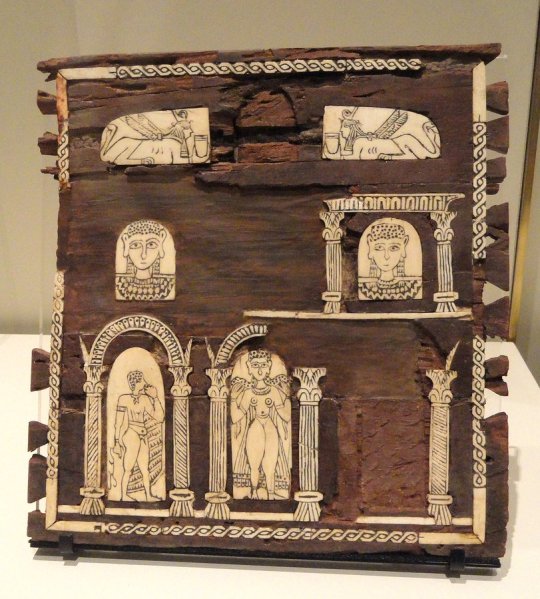
View On WordPress
#African Art#African History#ancient Nubia#Art#artfacts#Artifacts#christian nubia#ivory inlays#Jebel Adda#Nubian artisans#Nubian culture#Nubian Nile#Wooden casket
0 notes
Text
Best Scenery House Canvas Painting
Transform your living space with our breathtaking Scenery House Canvas Painting. Immerse yourself in the beauty of nature captured on high-quality canvases, depicting serene landscapes, charming cottages, and picturesque scenes. Our curated collection brings the outdoors indoors, adding a touch of tranquility and sophistication to your home. Each painting is a masterpiece, skillfully crafted to enhance your decor and create a visual escape. Elevate your surroundings with the timeless allure of Scenery House Canvas Paintings, where art meets the essence of home.
For more details,Visit: https://www.mahatribes.com/paintings

#canvas painting#simple canvas painting#canvas painting with acrylic paint#warli painting#painting#artifacts#home decoartion#warli#wooden craft
0 notes
Photo

Seated Bar Miami
Seated home bar - mid-sized transitional light wood floor seated home bar idea with granite countertops and multicolored countertops
0 notes
Photo

Seated Bar Miami
Seated home bar - mid-sized transitional light wood floor seated home bar idea with granite countertops and multicolored countertops
0 notes
Text
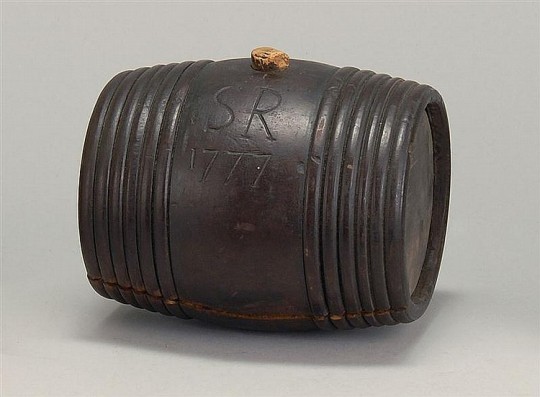
Wooden gun powder keg, inscriped with S.R. 1777
87 notes
·
View notes
Photo

Portland Living Room
Inspiration for a mid-sized contemporary formal and loft-style medium tone wood floor living room remodel with white walls, no tv, a standard fireplace and a concrete fireplace
#upholstered living room sofa#custom fireplace hearth#living room artifacts#loft-style#custom throw pillows#flat panel wooden cabinets
0 notes
Photo




AN EGYPTIAN POLYCHROME WOOD COFFIN PANEL
LATE PERIOD, 26TH DYNASTY, CIRCA 664-525 B.C.
80 1/4 in. x 17 1/4 in. (204 cm. x 44 cm.).
From the side of a wooden coffin, carved in sunken relief with eight standing deities facing left, wearing a short kilt and holding the was sceptre and the ankh symbol. Each figure is flanked by a column of text, identifying the deceased and each god, from left to righ: 'Shu'; 'Imsety, who gives life (to) P(a)wahibreemakhet', 'Anubis, who is upon his hill (?), Great God, Lord of the Sacred Land (cemetery)', 'Hapy, who gives life (to) P(a)ankhwahibre Wahibreemakhet', 'Osiris, who gives life (to) Ankhpawahibre Wahibreemakhet', 'Kebeh-senuef, who gives life (to) Ankhwahibre', 'Anubis, who is foremost in the God’s Booth, who gives life to Wahibreankh (or Ankhwahibre?)', and 'Isis, who gives life to Wahibreankh (or Ankjhwahibre?) Pawahibreemakhet'.
#AN EGYPTIAN POLYCHROME WOOD COFFIN PANEL#LATE PERIOD 26TH DYNASTY CIRCA 664-525 B.C.#ancient wooden coffin#ancient artifacts#archeology#archeolgst#history#history news#ancient history#ancient culture#ancient civilizations#ancient egypt#egyptian history#egyptian hieroglyphs
167 notes
·
View notes
Photo

Wooden Stake
Artist: David Palumbo
TCG Player Link
Scryfall Link
EDHREC Link
28 notes
·
View notes
Text
Surviving Aztec artifacts are usually made of stone and wooden ones usually rotted away long ago. But recently, right in the heart of Mexico City, archaeologists found over 2,500 wooden artifacts that are just stunning to look at and rarer than rare!
#Aztec#artifacts#wooden#Mexico City#Templo Major#temples#ancient#history#ancient origins#archaeology news
62 notes
·
View notes